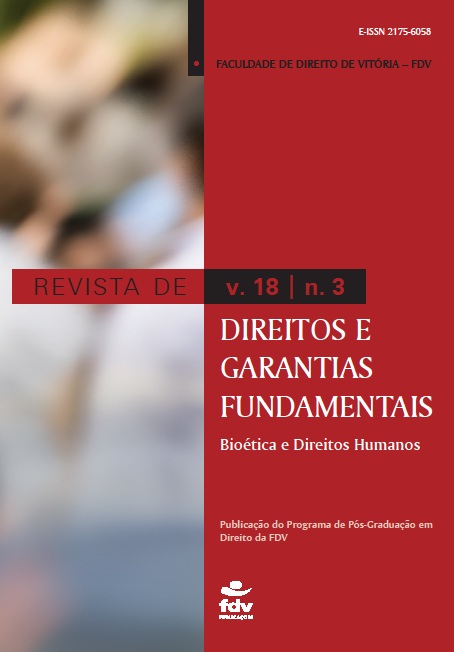Human dignity: a proposal of a bioethics framework based on principles
DOI:
https://doi.org/10.18759/rdgf.v18i3.1140Keywords:
Human dignity. Bioethics. Principles. Patient. Health care.Abstract
The idea that human dignity is a value is not sufficient to confer operability, so it should emanate prescriptive provisions, such as the principle of respect to the person; no the instrumentalization and the prohibition of humiliating, inhuman or degrading treatment. Considering a methodological perspective, it is a theoretical research based on a survey of bioethics literature. We have concluded that the principles of respect to the person; non instrumentalization and prohibition of humiliating, inhuman or degrading treatment are operating normative commands able to materialize the dignity of the patient. Thus, bioethical reflection on the patient healthcare from the perspective of human dignity should be taken into account the principles object of this investigation, because they are relevant ethical foundation for the analysis of ethical issues carried out by Hospital Bioethics Committees and Ethical Review Committees.
Downloads
References
ALBUQUERQUE, A. Direitos Humanos dos Pacientes. Curitiba: Juruá, 2016.
ALEXY, R. Teoria dos direitos fundamentais. São Paulo: Malheiros, 2008.
ANDORNO, R. Human dignity and human rights. In: TEN HAVE, H, GORDIJN, B (eds.). Handbook of Global Bioethics. Dordrecht: Springer, 2014. P. 45-57.
______. International policy and a universal conception of human dignity. In: DILLEY; S, PALPANT, NJ. Human dignity in bioethics. Nova Iorque: Routledge, 2013.p. 128-141.
______. Bioética y Dignidad Humana. Madrid: Tecnos, 2012.
______. Human Dignity and Human Rights as a Common Ground for a Global Bioethics. J Med Philos (2009)34 (3): 223-240.
BRISTISH INSTITUTE OF HUMAN RIGHTS. Your human rights: a guide for older people, 2010.
COHEN-ELIYA, M; PORAT, I. American balancing and German proportionality: the historical origins. I - CON (2010), v. 8 n. 2, 263–286
BAERTSCHI, B. Human dignity as a component of a long-lasting and widespread conceptual construct. Bioethical Inquiry. 2014.
CALHOUN, DH. Human excepcionalism and the Imago Dei. In: DILLEY; S, PALPANT, NJ. Human dignity in bioethics. Nova Iorque: Routledge, 2013.p. 19-45.
CHAN, D.K. The concept of human dignity in the ethics of genetic research. Bioethics. v. 29, n. 4, 2015: 274-282.
CHILTON. M. Developing a measure of dignity for stress-related health outcomes. Human Rights and Health Journal. v. 9, n. 2. 2006.p.209-225.
CONSELHO DA EUROPA. Convenção para a Protecção dos Direitos do Homem e da Dignidade do Ser Humano face às Aplicações da Biologia e da Medicina. Disponível em: http://www.gddc.pt/direitos-humanos/textos-internacionais-dh/tidhregionais/convbiologiaNOVO.html. Acesso em: 5 abril 2016.
DEPARTMENT FOR CONSTITUTIONAL AFFAIRS. A guide to the Human Rights Act 1998: Disponível em: <https://www.justice.gov.uk/downloads/human-rights/
act-studyguide.pdf>. Acesso em: 10 fev. 2015.
DILLEY; S, PALPANT, NJ. Human dignity in the throes? In: DILLEY; S, PALPANT, NJ. Human dignity in bioethics. Nova Iorque: Routledge, 2013.p. 3-18.
DÜWELL, M. Human dignity: concepts, discussions, philosophical perspectives. In: DÜWELL, M et al (ed.) Human dignity: interdisciplinary perspectives. Cambridge: Cambridge, 2014. p.23-52.
FOSTER, C. Human dignity in Bioethics and Law. Oxford: Portland, 2011.
GOBIERNO DE CHILE. ? Que es “trato digno” para los pacientes? Santiago: Departamento de Estudios e Desarrollo, 2013.
KASS, LR. Defending human rights. In: PELLEGRINO, ED; SCHULMAN, A; MERRILL, TW. Human dignity and bioethics. Indiana: Notre
Dame, 2009. p. 297 – 333.
KAUFMANN, P. Instrumentalization: What Does It Mean to Use a Person? KAUFMANN, P.
KUCH, H; NEUHÄUSER, C; WEBSTER, E (editors). In: Humiliation, degradation, dehumanization: human dignity violated. Londres: Springer, 2011. p.57-67.
KERSTEIN, S. Treating Others Merely as Means. Utilitas. v. 21, n. 2, June 2009.
LLERENA, VMG. De la bioética a la biojurídica: el principio y sus alternativas. Granada: Comares, 2012.
MACKLIN, R. Dignity is a useless concept. BMJ. 2003 Dec 20; 327(7429): 1419–1420.
McCORMICK, TR. Human dignity in end-of-life issues: from palliative care to euthanasia. In: DILLEY; S, PALPANT, NJ. Human dignity in bioethics. Nova Iorque: Routledge, 2013.p. 264-281.
NEVES, MCP; OSSWALD, W. Bioética Simples. Lisboa: Verbo, 2007.
NUSSBAUM, M. Human dignity and political entitlements. In: PELLEGRINO, ED; SCHULMAN, A; MERRILL, TW. Human dignity and bioethics. Indiana: Notre Dame, 2009. p. 351 – 262.
OLIVEIRA, AAS. Bioética e Direitos Humanos. São Paulo: Loyola, 2011.
OUTHWAITE, Wendy. The scope of impact of the Human Rights Act 1998 on healthcare and NSH resources allocation. In: GARWOOD-
GOWERS, Austen; TINGLE, John; LEWIS, Tom. Healthcare Law: the impact of the Human Rights Act 1998. Londres: Cavendish, 2001. p. 49-66.
RELATÓRIO BELMONT. Disponível em: http://www.fda.gov/ohrms/dockets/ac/05/briefing/2005-4178b_09_02_Belmont%20Report.pdf. Acesso em: 5 abril 2016.
SCHULMAN, A. Bioethics and the question of human dignity. In: PELLEGRINO, ED; SCHULMAN, A; MERRILL, TW. Human dignity and bioethics. Indiana: Notre Dame, 2009. p. 3 -18.
SPINKER, S. The stupidy of dignity. The New Republic. 2008.
STATMAN, Daniel. 2002. “Humiliation, Dignity and Self-Respect.” in The Concept of Human Dignity in Human Rights Discourse, edited by D. Kretzmer and E. Klein. Hague: Kluwer Law International.
UNESCO. Declaração Universal sobre Bioética e Direitos Humanos. Disponível em: http://unesdoc.unesco.org/images/0014/001461/146180por.pdf. Acesso em: 26 fev. 2016.
Downloads
Published
How to Cite
Issue
Section
License
Proposta de Aviso de Direito Autoral Creative Commons
1. Proposta de Política para Periódicos de Acesso Livre
Autores que publicam nesta revista concordam com os seguintes termos:
- Autores mantém os direitos autorais e concedem à Revista de Direitos e Garantias Fundamentais o direito de primeira publicação, com o trabalho simultaneamente licenciado sob a Creative Commons Attribution License que permitindo o compartilhamento do trabalho com reconhecimento da autoria do trabalho e publicação inicial nesta revista.
- Autores têm autorização para assumir contratos adicionais separadamente, para distribuição não-exclusiva da versão do trabalho publicada nesta revista (ex.: publicar em repositório institucional ou como capítulo de livro), com reconhecimento de autoria e publicação inicial nesta revista.
- Autores têm permissão e são estimulados a publicar e distribuir seu trabalho online (ex.: em repositórios institucionais ou na sua página pessoal) a qualquer ponto antes ou durante o processo editorial, já que isso pode gerar alterações produtivas, bem como aumentar o impacto e a citação do trabalho publicado (Veja O Efeito do Acesso Livre).


